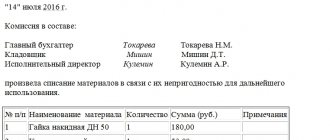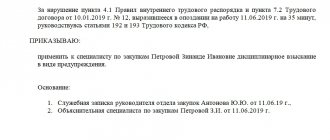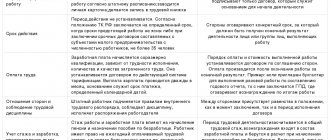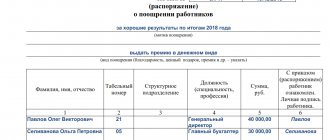What can be specified in the PVTR
In order not to complicate use, there is no need to outline all existing provisions of the Labor Code of the Russian Federation. Internal labor regulations must include information specific to a particular organization.
The internal labor regulations may include sections:
- General provisions. This part explains the purpose, scope of use of the document, and the circle of persons to whom they apply.
- The procedure for hiring and dismissing employees. This part lists the documents that must be provided when applying for a job, the conditions and duration of the probationary period. The registration algorithm and grounds for dismissal are explained in the same part.
- Basic rights and obligations of the parties. The content includes information about the rights and responsibilities of the employer and employee, methods of organizing activities, holding them accountable, guarantees to employees, etc.
- Working hours and rest times. This part determines the beginning and end of working hours, its duration, and contains information about the list of positions for which the working day is defined as irregular. In the same section, the lunch break time, the algorithm for granting days off and additional vacations are established.
- Payment procedure. The section contains information about the size, frequency, and place of payment of wages.
- Responsibility of the parties. This part describes the types of rewards for work and punishments, including the procedure for holding people accountable.
- Final provisions. This part defines the format for approval, approval and modification.
Depending on the specifics of the organization’s activities, the following items may be included in the internal labor regulations:
- procedure for maintaining summarized working time;
- procedure and timing of familiarization with shift schedules;
- list of positions with irregular working hours;
- duration of additional leave;
- the procedure and duration of providing time for heating and rest;
- the procedure for sending employees on business trips, registration and payment of related expenses;
- some others.
Managers have the right to include other information in the rules, for example, the procedure for paying for cellular communications, additional medical insurance, and compliance with the dress code.
The more detailed all the labor regulations are described, the fewer questions the employer will have if a controversial situation arises or during an inspection by the labor inspectorate. But at the same time, they should not contradict current legislation and worsen the situation of workers.
Are PVTR mandatory for LLCs and individual entrepreneurs?
Internal labor regulations are developed in accordance with the Labor Code of the Russian Federation in business entities without fail. This must be done by all organizations, including LLCs, as well as entrepreneurs acting as employers.
These acts may not be drawn up only by business entities classified according to certain criteria as micro-enterprises (for example, with up to 15 employees). They make up PVTR at will.
Such enterprises are allowed to waive their regulations in whole or in part. But they retain the responsibility to determine working conditions and conditions, so they must include this information in every contract drawn up during employment.
Who approves PVTR in the organization
Internal labor regulations are approved in accordance with Article 190 of the Labor Code of the Russian Federation.
After development, the employer must:
- send the project to the trade union committee of the institution for approval (if there is one);
- receive a reasoned response from the trade union on the legality of the provisions contained therein within 5 days;
- upon approval, approve it by order of the institution (there is no single order template, the main thing is that it must be available and approved directly by the head of the organization);
- bring the document to the attention of all employees in writing.
If there is no trade union in the institution, the local act is marked with o.
The validity period of the document is determined by the employer.
How to approve PVTR
When developing rules, a wide range of company specialists are usually involved in the process. These must include economists, lawyers and personnel personnel. At the same time, in their work they must take into account all the specifics of the enterprise, industry, product or service.
Once drafted, the draft document must be submitted to trade union representatives for review. This step is enshrined in law. They are given five days to review the document. The opinion expressed by the body can be either positive or negative.
In the latter case, an approval process must be carried out, which can take a long time. However, the administration, if the parties do not reach agreement for a long time, can approve the internal labor regulations of the organization in this form.
If this local normative act is included in the collective labor agreement, then the rules must then be registered with the labor inspectorate within seven days.
The final stage is the issuance of an order approving the labor regulations of the enterprise, which will put the document into effect. A person vested with the necessary powers, usually the director, has the right to sign it.
Attention! The adopted rules are subsequently used when drawing up employment contracts with employees.
How to familiarize employees with the rules
Everyone already working at the enterprise must be familiar with the rules, and new employees become familiar with them before signing an employment contract (Article 68 of the Labor Code of the Russian Federation). The fact of reading and taking note of the internal labor regulations is confirmed by the employee’s signature. This guarantees safety from a fine.
There are several ways to confirm that employees are familiar with the rules:
- Employees sign the familiarization certificates, which are filed with the PVTR.
- Employees sign in specially established familiarization logs.
- The signature must be on a special familiarization sheet for each employee. Typically, such sheets contain a complete list of acts that must be read by the employee.
- In the employment contract.
The employer chooses the method that is more convenient for him.
How to make changes to PVTR
Over time, changes and amendments may be made to the main legislative acts, and new organizational and technological processes may be introduced into the work of the enterprise. In order for previously adopted internal labor regulations to always be relevant, they need to be amended in a timely manner.
The need to make changes is documented in an official or memo addressed to the company administration. After this, the administrative act must appoint persons who will be responsible for developing a new version of the rules.
Since the procedure for amending the laws is not specified anywhere, it is recommended that when developing and adopting a new version of the rules of procedure, one should adhere to the procedure carried out during the primary process.
Important! After accepting the new version of the document, all company employees must be familiarized with it against signature.
What is not regulated
The 2020 labor regulations have restrictions on content. They are prohibited from establishing standards that violate the law or worsen the situation of employees.
The error is:
- requirement when hiring additional documents not provided for in Art. 65 Labor Code of the Russian Federation;
- criminal record check for a position category for which one is not provided;
- requirement to provide a signed bypass sheet, in its absence - refusal to make a full payment upon dismissal;
- establishment of disciplinary sanctions that do not exist in labor legislation (such as “severe reprimand”);
- ban on part-time work;
- ban on doing business;
- lack of indication of start, end and work breaks;
- lack of indication of salary payment dates;
- lack of indication of the duration of additional leave.
Basic rules of VTR
When developing internal labor regulations, it is necessary to proceed from those listed in Art. 189 of the Labor Code of the Russian Federation important components for it, without forgetting about corporate nuances. Each employer decides for himself in what volume and composition this document will be drawn up.
Approximate content of internal labor regulations:
- general provisions (purpose of rules, development goals, scope of distribution and other organizational issues);
- hiring and dismissal of employees;
- rights and obligations of the employer and employees;
- work and rest time;
- labor discipline (discipline and encouragement of employees);
- final provisions.
The first (general) organizational section, in addition to what is listed, may include terms and definitions used in these rules.
The description of the procedures associated with the admission, transfer or dismissal of employees can be supplemented by a list of documents required from the employee upon admission to work and issued by the company itself during the employee’s labor activity.
IMPORTANT! Art. is devoted to employment issues. 68 of the Labor Code of the Russian Federation, and the dismissal process requires compliance with the requirements of Art. 77–84.1, 179–180 and other articles of the Labor Code of the Russian Federation.
When developing rules regarding the rights and obligations of the employer and employees, not only a formal listing is required, but also verification of their compliance with the requirements of labor legislation (Articles 21, 22 of the Labor Code of the Russian Federation).
Infringing on the rights of employees, as well as imposing unnecessary responsibilities on them by the employer, is unacceptable. In this regard, a trade union committee or other body guarding the observance of the legitimate interests of workers can have a significant influence on the content and composition of the VTR rules.
Sample internal labor regulations
Check that the finished document contains the required details:
- name of company;
- name of the document type;
- details and name of the document by which they are approved;
- all pages of the rules must be numbered;
- applications (if available) are an integral part of the requirements and are continuously numbered.
Is it possible not to say
Should the organization have standard labor regulations in all cases? There is one exception. It applies to organizations that have the status of “microenterprise”. They may not approve standard rules. The reason is simple: in accordance with Art. 309.2 of the Labor Code of the Russian Federation, a microenterprise has the right not to adopt local acts at all in terms of labor standards. In this case, all provisions that are required to be included in the rules (Part 4 of Article 189 of the Labor Code of the Russian Federation), including the need to comply with labor discipline, must be included in labor agreements with micro-enterprise employees.
If an organization loses its “microenterprise” status, then it is obliged to develop, approve and apply rules (Part 3 of Article 309.1 of the Labor Code of the Russian Federation). This must be done no later than 4 months from the day when adjustments are made to the Unified Register of Micro-Enterprise Subjects regarding the status of the company.
But it is still advisable to approve the rules even for micro-enterprises. In this case:
- labor agreements with employees, if there are rules, will not be too “overloaded” with norms;
- if status is lost, there will be no need to urgently develop a document.
Labor Code norms in PVTR
The above list, not counting the last point, lists everything that internal labor regulations should contain. And if any of the sections in the PVTR are missing, labor inspectors will probably notice this during the inspection and issue an order to eliminate the violation (Appeal ruling of the Perm Regional Court dated October 1, 2014 N 33-8841). However, this does not mean that every employer must transfer half of the provisions of the Labor Code to its labor regulations.
Of course, PVTR are drawn up in accordance with the norms of the Labor Code of the Russian Federation and other regulations. After all, if some points of the organization’s internal regulations worsen the employee’s position in comparison with established labor legislation, then they should not be applied (Article 8 of the Labor Code of the Russian Federation). But when drawing up the PVTR, it is important not just to quote the Labor Code norms in them, but to try to take into account the peculiarities of the work of your organization.










